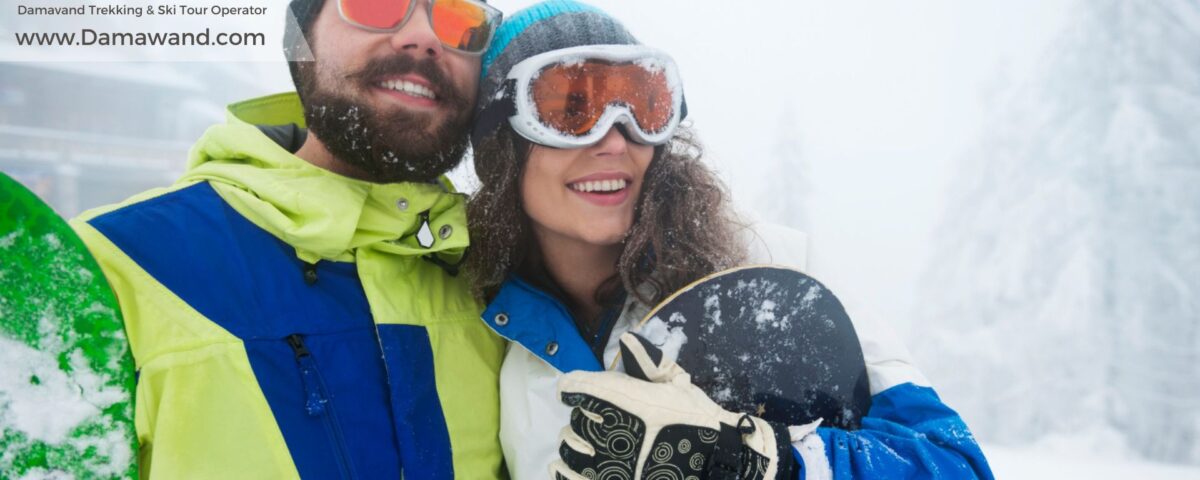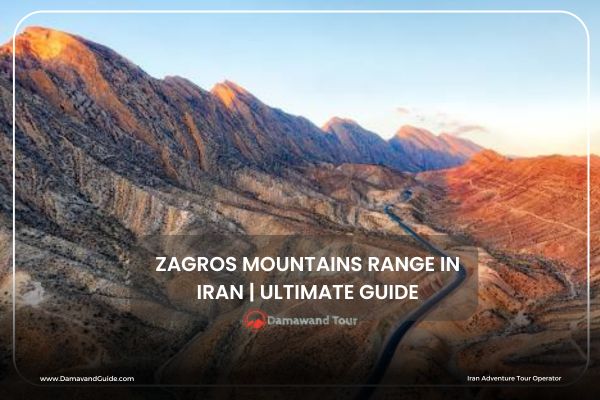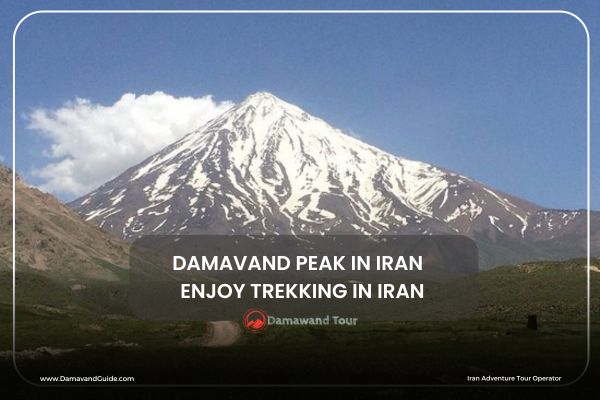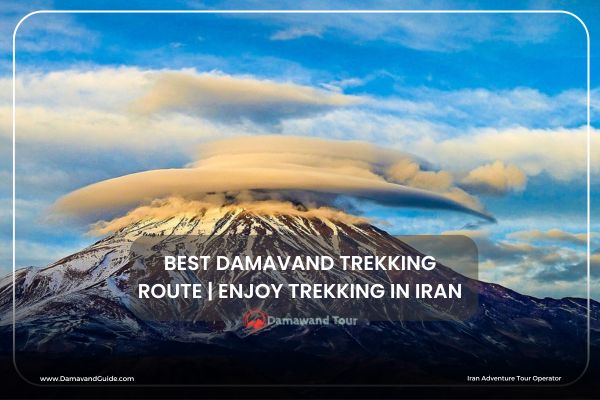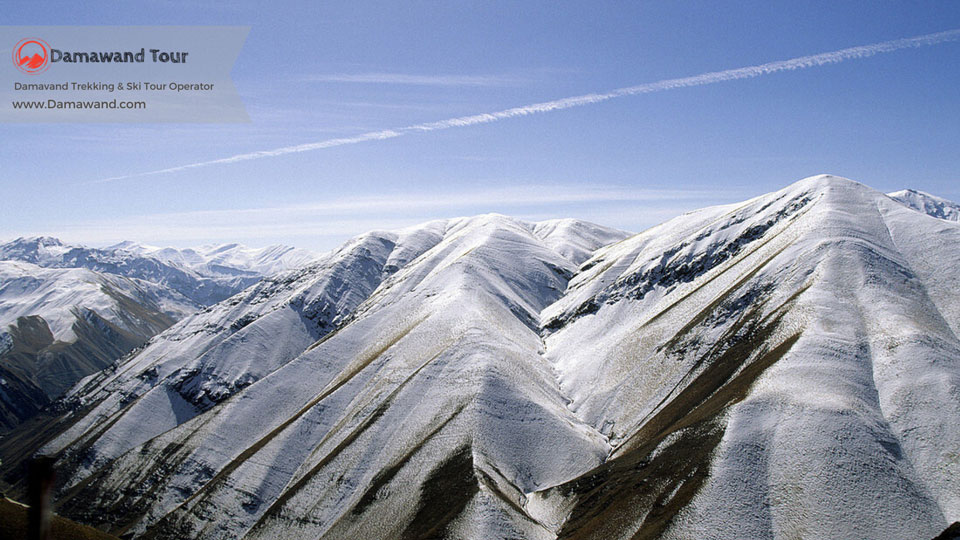
Alborz Mountain Range in Iran
October 28, 2023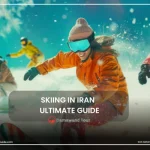
Skiing in Iran 2025 | Ultimate Guide
November 27, 2023Best Skis of 2025| All-Mountain Ski Buying Advice
Are you ready to carve your way through the powdery slopes and conquer the mountains in style with the best skis of 2024? Whether you’re an adrenaline junkie or a casual skier, having the right pair of all-mountain skis can make all the difference. The 2024 skiing in Iran season is upon us, and you’re probably wondering which are the top-performing and best all-mountain skis to invest in. Well, fear not, because we’ve got you covered with the ultimate All-Mountain Ski Buying Advice!
In a nutshell, the top performers for 2024 are here to revolutionize your skiing experience with the best skis of 2024. From unparalleled speed to exceptional maneuverability, these skis are engineered to make every descent memorable. But who are the star players? We’ll reveal it all in just a moment, so stay tuned!
But these are not the only options for you to explore in the realm of all-mountain skiing. Our comprehensive guide, backed by insights from skiing experts and seasoned pros, will lead you to the perfect choice for your style and skill level. So, without any further ado, let’s dive into the world of the best all-mountain skis of 2024 and elevate your skiing adventures to new heights. Tell us, are you ready to hit the slopes with the best skis of 2024 by your side?

What Is an All-Mountain Ski?
When looking at different types of skiing, one of the most versatile ski types is the all-mountain ski. These skis are known for their ability to handle a wide range of conditions, making them a great choice for both beginners and advanced skiers. All-mountain skis, often called the “quiver of one,” are designed to perform well across various terrains. Whether you’re skiing on groomed trails or venturing into powder, these skis adapt well to many conditions.
- Versatility: All-mountain skis are typically between 80mm and 105mm wide at the waist, allowing them to navigate both frontside groomers and deeper snow in the back bowls.
- Performance: Narrower all-mountain skis are great for carving turns on hard-packed snow, while wider ones can float better in powder
However, it’s important to note that all-mountain skis may not be perfect for every condition. Deep powder skiers or racers looking for highly specialized skis might find them lacking in specific areas. They also tend to be heavier, which makes uphill travel more challenging.
If you’re looking for one ski that can handle most skiing adventures, all-mountain skis are a solid choice. Be sure to match your ski to local snow conditions, your style, and skill level to get the best experience on the slopes.
At the narrower end of the spectrum, you’ll find on-trail groomer skis, optimized for carving precise turns. On the wider end, these skis are capable of handling back bowls and powder conditions with ease. In other words, a quality all-mountain ski, turning with powder spray, can adapt to a wide range of snow conditions, making it an excellent choice for those seeking an all-in-one solution.
However, it’s crucial to recognize the limitations of all-mountain skis. They may not be the best choice for deep powder enthusiasts or ex-racers looking for dedicated carving skis. Additionally, they tend to be heavier for uphill travel, although advancements in materials are gradually addressing this issue. What makes them stand out is their ability to cater to various conditions, from hard-packed trails to soft, pristine snow on sunny days. However, choosing the right all-mountain ski isn’t as straightforward as picking any model. It requires considering factors like local snow conditions, your skiing style, and skill level.
Read More:
Mount Damavand Ski Tours in Iran
7 Days Popular Mt Damavand Ski Tour | Mountaineering Ski Package in Iran
What Is Ski Waist Width?
When considering the best skis, one critical aspect to account for is the waist width, a measurement taken from the ski’s center at its narrowest point. This measurement plays a vital role in narrowing down your search. In the all-mountain ski market, you’ll encounter a broad range of options, spanning from approximately 75 millimeters to around 110 millimeters. Your choice within this spectrum is influenced by various factors, including your skiing style, the characteristics of the local terrain, and prevailing snow conditions. Notably, many well-regarded ski lines offer a variety of widths to cater to diverse preferences. For example, Atomic’s Bent collection boasts sizes ranging from 85 to 120 millimeters, providing a comprehensive selection that caters to a wide range of all-mountain styles.
All-mountain skis often come in different widths to accommodate various riding styles and adapt to changing conditions. When it comes to width recommendations, skis on the narrower end of the spectrum, like Rossignol’s Experience 78, are ideally suited for hardpack and firm snow conditions. They typically offer easy maneuverability and excellent grip during turns but may struggle in powder snow.
The core of the all-mountain market falls within the 88- to 100-millimeter waist width range, striking a harmonious balance between flotation in moderate snowfall (typically up to around 6 inches of powder, depending on design) and dependable on-piste performance. Once you venture beyond 100 millimeters at the waist, you enter the realm of borderline powder skis. These skis excel in deep powder conditions but may compromise their grip on groomed trails.
Here are some general recommendations based on terrain and region:
- All-Mountain Groomer Skis: Opt for skis with a waist width of 75mm to 90mm.
- All-Mountain East Coaster: Consider skis with a width ranging from 80mm to 95mm.
- Heart of the All-Mountain Range: Skis with a waist width of 88mm to 100mm offer a versatile balance.
- All-Mountain Rocky Mountains/West Coaster: For this region, look for skis with a waist width of 90mm to 105mm.
- All-Mountain Powder Skis: If you’re primarily focused on powder skiing, consider skis with a width of 100-110mm.
These guidelines serve as a starting point to help you select the best skis tailored to your specific needs, but they should be further informed by your individual preferences and the specific characteristics of the skiing terrain and conditions you’ll encounter.

All-Mountain and Freeride skis are two distinct categories, each offering unique features to cater to specific preferences and help you choose the best skis for your needs.
All-Mountain Skis: The all-mountain category is known for its versatility, attempting to cover a broad spectrum of skiing styles and terrains, making it essential when considering the best skis for your adventures. However, as we explained earlier, there are significant differences between models, primarily determined by waist width. To provide clarity, we often categorize all-mountain skis into two subcategories: “all-mountain front” and “all-mountain back.”
All-Mountain Front Skis: These skis are optimized for tackling groomed runs and are among the best skis for on-piste adventures. They feature a narrower waist width, semi-stiff to stiff construction, and a ski profile that prioritizes stability and excellent edge hold on hardpack. Examples of all-mountain front skis include the Rossignol Experience 86 Ti and Völkl Kendo 88, two top choices for those seeking the best skis for groomed terrain.
All-Mountain Back Skis: In contrast, all-mountain back skis are designed for off-trail adventures, with a focus on navigating deep snow. They have wider waists, a softer build, and are constructed to float effectively in powder. While they may not offer the same level of carving ability and on-piste stability, they are well-suited for skiers spending a significant portion of their time off-piste, making them among the best skis for powder. The Salomon QST at 106mm in width is an example of all-mountain back skis, a strong contender for the best skis in deep snow.
Freeride Skis: Freeride skis, on the other hand, are tailored for a specific type of skiing—off-piste and deep powder. These skis have wider waists, typically ranging from 100mm to 130mm or more, and feature pronounced rocker profiles for enhanced floatation and maneuverability in deep snow. They excel in challenging off-piste terrain and are best suited for advanced to expert skiers seeking the best skis for an exceptional powder experience.
Your choice between all-mountain and freeride skis should align with your skiing preferences, skill level, and the type of terrain you most enjoy. All-mountain skis offer versatility for a variety of conditions, with the option to choose front or back models based on your focus. Freeride skis, in contrast, are specialized for off-piste and deep powder adventures, prioritizing floatation and performance in challenging terrain, making them some of the best skis for powder enthusiasts.
What is a camber and rocker on a ski?
When it comes to selecting the best skis, it’s crucial to understand the ski’s profile, which can be categorized into three main types: camber, rocker, and mixed rocker/camber. While other profiles exist, these three are the most popular and offer their unique strengths and weaknesses tailored to different skiing styles and snow conditions.
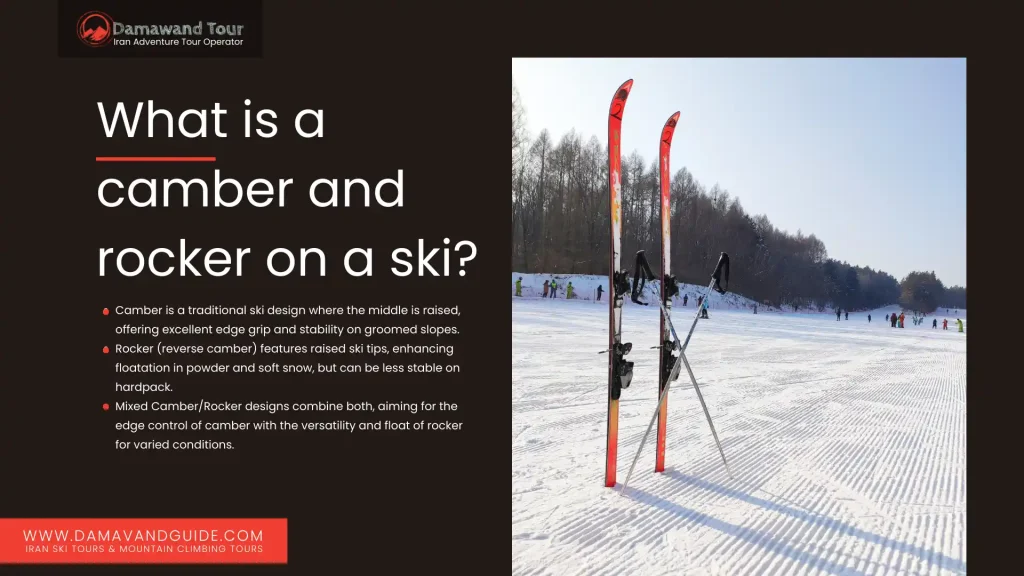
Camber:
Camber is the traditional design for groomer skis, making it an important consideration when seeking the best skis for carving down groomed slopes. Visually, camber is characterized by the part of the ski that’s raised off the snow when the unweighted ski is placed flat on the ground. When a cambered ski is weighted during a turn, it allows the ski’s edge to grip the snow surface, enhancing stability and edge hold. As the skier exits the turn, camber helps propel them into the next one.
Although full camber used to dominate the all-mountain ski category, it has become less common due to the increased popularity of rocker and mixed camber/rocker designs, which are more versatile in soft or choppy snow. Nevertheless, traditional camber remains an excellent choice for skiers who prefer aggressive skiing on groomed runs, even if they encounter some performance compromises in deeper snow.
Rocker:
Rocker, also known as reverse camber, is recognized by the ski’s raised tips on both ends, creating a banana-like shape to the ski profile. Initially designed for its advantages in deep powder skiing, rocker skis were primarily associated with powder skiing. However, rocker has gained traction in all-mountain ski setups. A full rocker design, with both tips and tails rising, is best suited for skiers who spend more time off-piste. It excels in powder and soft snow but may be less stable on hardpack, making it a popular choice for adventurous skiers.
Mixed Camber/Rocker:
To combine the benefits of both rocker and camber, manufacturers have introduced mixed camber/rocker designs. This category aims to offer the best of both worlds: the edge control of a traditional camber ski and the versatility of rocker, especially in challenging conditions like deep powder. Variations exist in how this mix is implemented, with some featuring tip-only rocker and others incorporating tip and tail rocker. The latter is beneficial for skiers who ride in a switch position. For those who want a well-rounded skiing experience across the mountain, a mixed camber/rocker setup can be an excellent choice.
When considering the best skis, the ski’s profile is a key factor to evaluate. Camber is ideal for groomed runs, while rocker excels in soft snow and off-piste terrain. Mixed camber/rocker designs aim to provide a balanced experience for a wide range of skiing styles and abilities. Ultimately, the choice of ski profile should align with your skiing preferences and the terrain you most frequently encounter.

What Is Turn Radius (Sidecut) And What Does It Do?
Turn radius, also known as sidecut, is a fundamental characteristic of a ski, closely related to its shape and profile. This measurement, typically listed in meters, determines the curvature and behavior of the ski when making turns. The turn radius is derived from the ski’s tip, waist, and tail dimensions and is a valuable indicator when considering the best skis for your skiing style.
The turn radius directly influences how a ski performs in various aspects:
Turning Performance: The turn radius defines a ski’s turning performance. Skis with a smaller turn radius have a quicker, tighter turn radius, making them adept at short, rapid turns. They are ideal for slalom-style skiing and navigating tight spaces. Conversely, skis with a larger turn radius create wider, slower turns, excelling in long-radius turns and maintaining stability at high speeds.
Carving Ability: The shape of the ski’s sidecut, determined by the turn radius, significantly impacts its carving ability. Skis with a smaller turn radius feature a deeper sidecut, allowing for more aggressive edge engagement and precise carving. Larger turn radius skis have a shallower sidecut, making them suitable for long, sweeping turns with gradual edge engagement.
Versatility: Turn radius also influences a ski’s versatility. Smaller turn radius skis are agile and responsive, suitable for slalom racing, mogul skiing, and maneuvering in challenging terrain. In contrast, skis with a larger turn radius offer a balance between short and long turns, making them versatile for all-mountain skiing.
Skill Level: The choice of turn radius can affect the ski’s suitability for different skill levels. Skis with a shorter turn radius are often forgiving and accessible, making them a preferred choice for intermediate skiers. Skis with a longer turn radius may demand more skill and control, appealing to advanced and expert skiers.
For instance, the Head Kore 93 features one of the shortest turn radii on our list at 16.4 meters, with tip, waist, and tail dimensions of 133mm, 93mm, and 115mm, respectively. This indicates its nimble and quick-turning nature, making it a suitable choice for tight spaces and moguls.
Turn radius, combined with rocker/camber profiles and stiffness, contributes to a ski’s overall performance characteristics. When considering the best skis for your skiing style, the turn radius number provides valuable insights into how the ski will behave on the slopes.
To provide further context, here’s a general guideline for turn radii performance:
- Carving: Less than 16 meters
- All-Around: 16-20 meters
- Wide and Sweeping Turns: 20+ meters
Understanding the significance of turn radius (sidecut) is essential when selecting the best skis tailored to your preferred skiing style and the conditions you’ll encounter on the mountain.
Ski Construction and Materials
Contemporary all-mountain skis come packed with advanced components and exclusive technologies, often with catchy but bewildering names. This can make it tricky to assess their makeup without practical testing. The good news is that the current market offers a range of top-quality options, with incremental improvements every year. Poplar and aspen are two lightweight, high-energy woods frequently used in the ski’s core. They reduce weight while maximizing bounce and responsiveness. Paulownia, another lightweight choice, is often slightly more durable. Denser woods like maple enhance power, stability, and longevity, albeit with some added weight. Beyond the wood core, ski manufacturers commonly incorporate metal or composite materials such as graphene, carbon, Titanal, or proprietary blends to enhance the ski’s strength and rigidity.
If you’re in the market for a high-end ski, it’s worth considering these materials. However, avoid restricting yourself by setting too many specific criteria. Determining a ski’s performance solely from its construction can be challenging, as there are numerous ways to create a capable design. When researching your next ski purchase, pay attention to how the manufacturer describes overall performance, but be cautious about extravagant claims. If possible, try out skis with different materials, constructions, and even varying lengths to get a feel for how they perform under your feet.
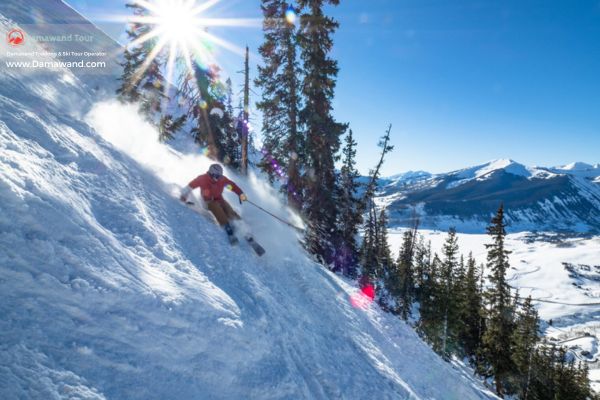
Ski Ability and Flexibility
The firmness of a ski is a crucial aspect that sets apart skis designed for beginners from those for advanced skiers. A stiff ski offers stability at high speeds and the potential for exceptional performance. However, it can be challenging for beginners or less confident skiers to control and make turns. Conversely, choosing a ski that’s overly soft can limit its top-end performance, leaving advanced or progressing skiers desiring more. Many of our preferred ski models strike a balance, providing the power needed for controlling the skis while maintaining enough flexibility for forgiveness and maneuverability, especially at slower speeds.
A ski’s stiffness results from the materials used in its construction, with a key factor being the presence of metal. Stiff skis often feature two layers of Titanal, a robust alloy, extending the full length and width of the ski. While this metal adds weight, it significantly enhances stability. Expert-level skis like the Blizzard Bonafide employ this construction. On the other end of the spectrum, softer skis like the J Skis The Allplay opt to exclude metal entirely. These skis prioritize playfulness over speed and are better suited for off-piste exploration, leisurely speeds, and intermediate skiers. Finally, some of the most popular skis on the market strike a harmonious balance between performance and flexibility, exemplified by models such as the Nordica Enforcer 94 and Dynastar’s M-Pro 99.
The flexibility of a ski is a crucial factor to consider when searching for the best skis, as it directly influences how the ski handles and responds to your skiing style and skill level.
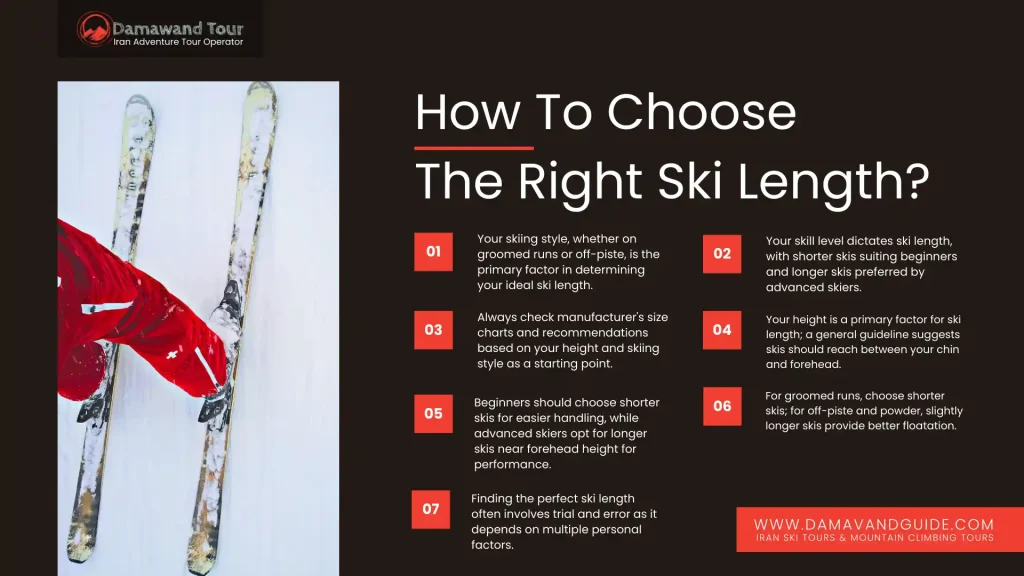
How To Choose The Right Ski Length?
Choosing the correct ski length is a critical step in ensuring a great skiing experience, as it directly impacts your control, stability, and maneuverability on the slopes. The ideal ski length is determined by several factors, including your skiing style, skill level, terrain, and personal preferences. Let’s break it down to help you make the right choice:
1. Determine Your Skiing Style:
Begin by considering your skiing style. Are you mainly skiing on groomed runs or venturing off-piste into powder? Your skiing style influences your preferred ski length.
2.Assess Your Skill Level:
Your skiing skill level plays a significant role in selecting the right ski length. Generally, shorter skis are more manageable for beginners, while longer skis are favored by advanced and expert skiers.
3.Consult Manufacturer’s Recommendations:
Many ski manufacturers provide size charts and recommendations based on your height and skiing style. These can serve as a useful starting point for choosing the right ski length.
4.Take Your Height into Account:
Your height is a primary factor when determining ski length. As a general guideline, your skis should fall within the range between chin and forehead height when standing upright. Shorter skis offer better control, while longer skis provide more stability at higher speeds.
5.Adjust for Skill Level:
Beginners should opt for shorter skis, as they are easier to manage and maneuver. Intermediate skiers can select skis closer to chin height to balance control and stability. Advanced and expert skiers may prefer skis at or slightly above forehead height for enhanced performance.
6.Consider the Terrain:
Think about the type of terrain you’ll be skiing on. Shorter skis are suitable for groomed runs, while slightly longer skis may be preferred for off-piste and powder skiing, offering better floatation.
7.Trial and Error:
It’s important to understand that there is no fixed formula for determining the perfect ski length. Ski length depends on multiple factors, and it may take some trial and error to find what suits you best.

Short or Long Skis?
Shorter skis are known for their agility, quick turns, and maneuverability at lower speeds.
Longer skis excel at higher speeds due to their longer turn radius and increased stability.
Personalized Considerations:
Taller and heavier individuals may benefit from longer skis, as they provide better leverage.
Shorter individuals with lighter body weight may feel more comfortable with shorter skis.
Remember that ski length is not solely dependent on height, and personal preferences and performance level also play a role.
Performance Level Guidelines:
Beginner Skiers:
Beginners should prioritize control and stability, making shorter skis a suitable choice. However, comfort and ease of use should also be considered, so choose a length that aligns with your height and weight.
Intermediate Skiers:
Intermediate skiers who are confident and comfortable with parallel skiing can look for skis that match their skill level. Consider where you’ll be skiing, as terrain can affect your choice.
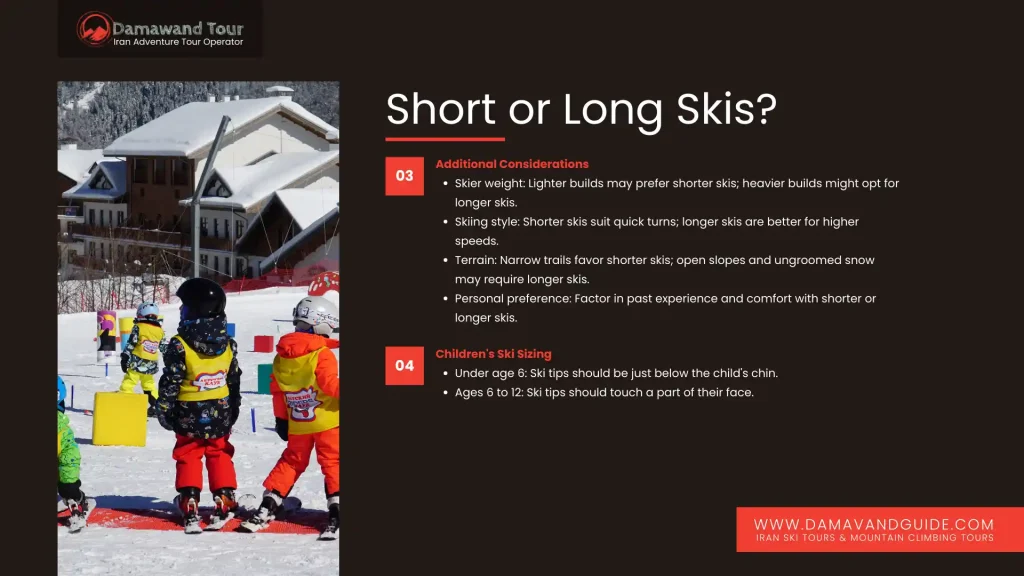
Advanced Skiers:
Advanced skiers ready to conquer challenging trails and turns can benefit from longer, stiffer skis. Longer skis offer higher performance at greater speeds and precise technique for advanced trails.
Ski Sizing Chart:
Here’s a general ski sizing chart to provide an approximate range of ski lengths based on your height:

Remember, several other considerations come into play:
Skier weight: Your weight can influence your ski length choice. Slight builds may prefer shorter skis, while larger frames might opt for longer skis.
Skiing style: Shorter skis are better for quick turns, while longer skis are ideal for higher speeds.
Terrain: Narrow, twisty trails favor shorter skis, while open slopes and ungroomed snow may require longer skis.
Personal preference: If you have a preference for shorter or longer skis based on experience, consider that in your choice.
For children:
Under age 6, stand skis next to the child with the tips just below the chin.
Ages 6 to 12, have the ski tips touch a part of their face.
Choosing the right ski length is a combination of height, skiing style, skill level, terrain, and personal comfort. While guidelines help, experimenting and getting expert advice can ultimately lead you to the perfect ski length for your unique needs.
Selecting the Right Ski Boots and Bindings for the Best Skis
Choosing the right ski boots and bindings is crucial for your skiing comfort, performance, and safety. These components directly affect how you control your skis, and finding the perfect fit is essential, especially when you’re aiming for the best skis. Here’s a step-by-step guide to help you make the right choices:
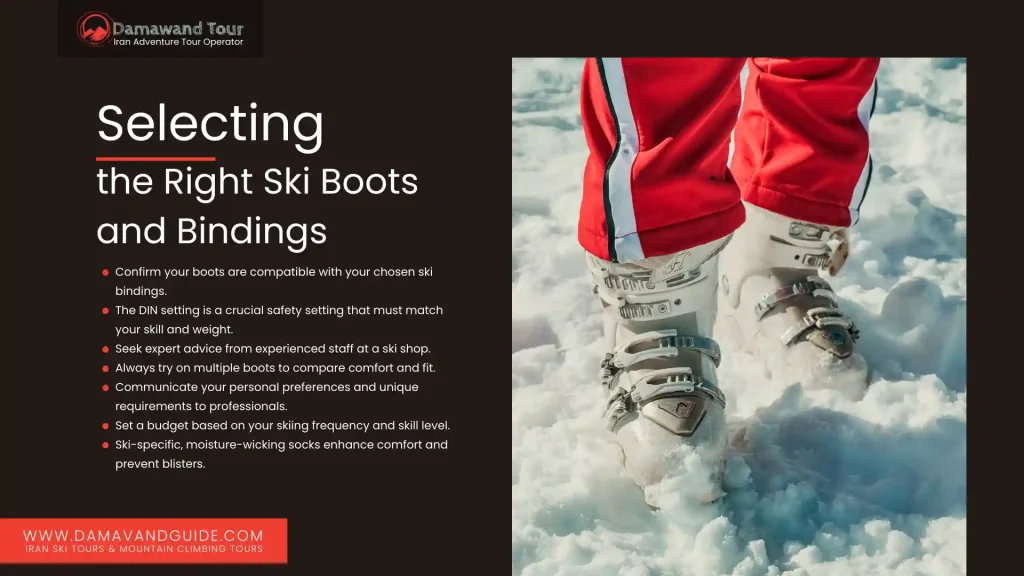
1. Determine Your Skiing Style:
Your skiing style will influence your boot and binding selection, ensuring that you’re fully prepared to make the most of the best skis. Are you a casual skier who enjoys leisurely runs, or are you an aggressive skier who loves challenging terrain and high speeds.
2.Assess Your Skill Level:
Your skiing skill level plays a significant role in boot and binding choice, which is especially vital when you’re seeking the best skis. Beginners may prefer more forgiving boots, while advanced skiers may require high-performance options.
3.Visit a Professional Boot Fitter:
A professional boot fitter can measure your feet, analyze your skiing style, and recommend boots that provide the best fit and performance. They can also make custom adjustments for comfort, ensuring you’re fully prepared for the best skis.
4.Consider Boot Flex:
Boot flex refers to how much resistance the boot offers to forward movement, a critical factor when you’re aiming for the best skis. Softer boots are more forgiving and suitable for beginners, while stiffer boots provide more precise control and are preferred by advanced skiers.
5.Check for Boot Width:
Different boots come in various width options, and ensuring the right fit is crucial when you’re pursuing the best skis. Make sure the boot width matches your foot shape. Boots that are too narrow can be uncomfortable, while overly wide boots may compromise control.
6.Explore Boot Liners:
The boot liner is the inner padding of the ski boot. Some boots offer heat-moldable liners that can conform to the shape of your feet for a custom fit. High-quality liners enhance comfort, which is essential when you’re chasing the best skis.
7.Binding Compatibility:
Ensure that your ski boots are compatible with your chosen ski bindings for the best skis. Different bindings are designed for specific boot sole types, such as alpine, alpine touring, or tech bindings, ensuring a seamless connection for the best skis.
8.Consider the DIN Setting:
The DIN setting on ski bindings determines the release tension when a fall occurs, a crucial factor for safety when you’re striving for the best skis. This setting should match your skill level and weight, and a professional technician can help set the DIN correctly.
9.Seek Expert Advice:
Visit a reputable ski shop and consult with experienced staff or a boot fitter, especially if you’re looking for the best skis. They can guide you in selecting the appropriate boots and bindings based on your skiing style and individual needs.
10.Test and Try On:
Always try on multiple ski boots to compare comfort and fit. Walk around in them to assess comfort and ensure they don’t create pressure points, vital for a comfortable experience with the best skis.
11.Consider Personal Preferences:
Your skiing comfort is highly personal, and discussing your preferences is essential when you’re in pursuit of the best skis. If you have specific needs or unique requirements, communicate them with the professionals helping you choose your boots and bindings.
12.Budget Considerations:
Ski boots and bindings come in a wide price range. Set a budget based on your skiing frequency and skill level. High-end options often offer advanced features but come at a higher cost, which is important when you’re after the best skis.
13.Don’t Forget About Socks:
Choose ski-specific socks made from moisture-wicking materials. Proper socks can enhance comfort and prevent blisters, ensuring you’re ready for the best skis.
Finding the right ski boots and bindings involves considering your skiing style, skill level, foot shape, and individual preferences. A professional boot fitter can be a valuable resource in ensuring a proper fit, especially when you’re gearing up for the best skis. Well-fitted and compatible boots and bindings are essential for a safe and enjoyable skiing experience, so take your time to make the right choices and fully prepare yourself for the best skis.
Best Overall All-Mountain Ski
Blizzard Rustler 10 ($800)
- Ski Model: Blizzard Rustler 10
- Ski Category: All-mountain
- Recommended Skill Level: Intermediate to expert
- Ski Dimensions: 134-102-123mm
- Available Widths: 96, 112mm
- Positive Aspects: An exceptional versatile ski that excels on hardpack, performs well in soft snow, and handles crud admirably.
- Considerations: Slightly more demanding and less playful compared to the original Rustler.
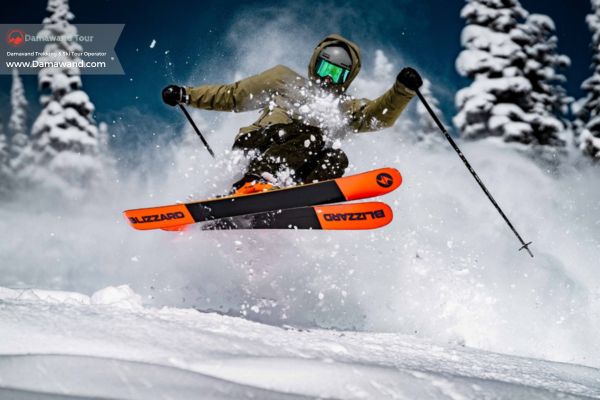
While Blizzard’s Brahma and Bonafide have been recognized for their aggressive performance on hardpack, we must admit a preference for the more forgiving Rustler when it comes to genuine all-mountain usage. The Rustler lineup offers skis in three widths, ranging from 112 millimeters (Rustler 11) to 96 millimeters (Rustler 9). The middle-ground “10” version, at 102 millimeters underfoot, presents a well-balanced blend of rocker, camber, and stiffness in its construction, making it our go-to ski for everyday use during the last winter season. It quickly won our approval, proving itself to be exceptionally stable on groomed trails, impressive in boot-top powder, and surprisingly maneuverable despite its moderately wide dimensions. For individuals seeking a single ski that can handle diverse mountain terrain during a day’s adventure, such as forays into the sidecountry, the Rustler 10 is a top choice.
The previous-generation Rustler used to be our top “playful” selection, but Blizzard has added more Titanal to the latest model, running it along the ski’s perimeter, including the tip and tail. This enhancement results in improved edge grip and enhanced stability at high speeds. Fortunately, they managed to keep the ski’s weight in check, and there’s sufficient tip flex to provide forgiveness in soft snow and accommodate intermediate skiers. However, those who enjoy taking creative lines down the mountain might miss the playful, freestyle characteristics of the original Rustler (in that case, the Atomic Bent 100 is a better fit). Nevertheless, the trade-off yields a fantastic all-rounder, particularly suitable for those who spend a significant amount of time off the beaten path, especially on the West Coast.
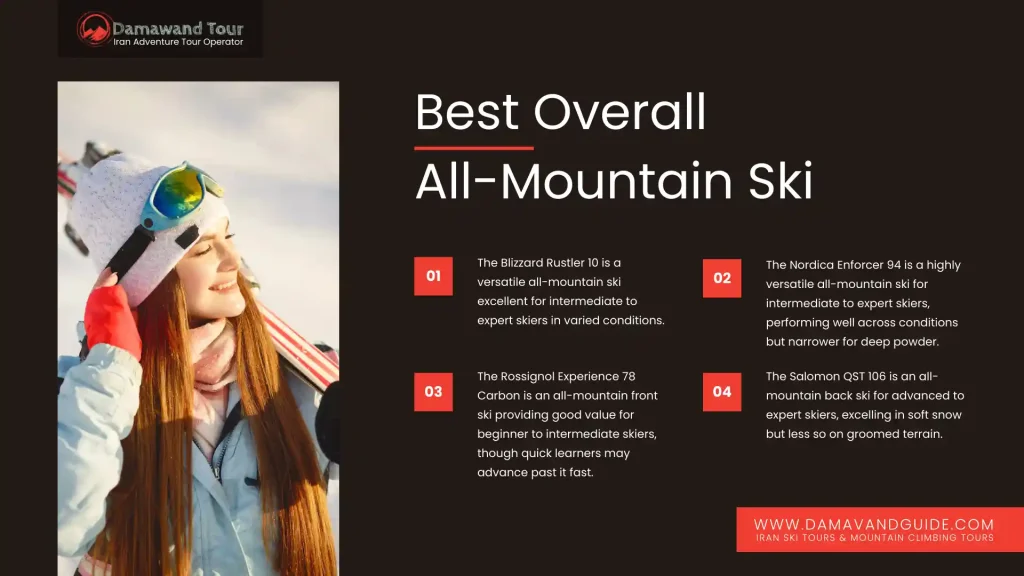
Nordica Enforcer 94 ($800)
- Ski Model: Nordica Enforcer 94
- Ski Category: All-mountain
- Recommended Skill Level: Intermediate to expert
- Ski Dimensions: 127-94-115.5mm
- Available Widths: 88, 100mm
- Positive Aspects: Exceptionally versatile and well-rounded within the all-mountain category.
- Considerations: Slightly narrower for deep powder conditions.
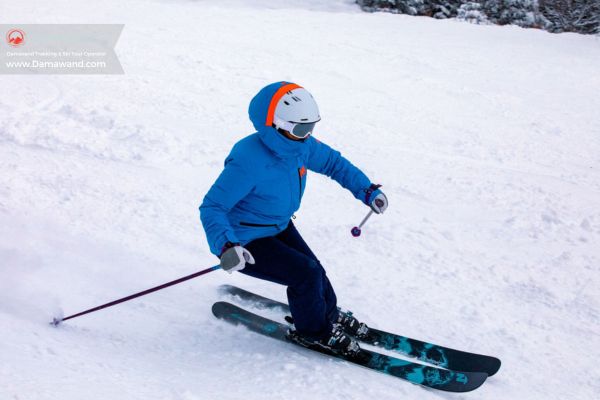
Introducing updates to a highly successful model can be a risky endeavor, but we believe that Nordica has successfully elevated the latest Enforcer line. Among its various iterations, the mid-width “94” stands out as our favorite for all-mountain usage, largely owing to its combination of strength and enjoyable characteristics. Significant refinements to the design, such as an increased use of carbon fiber and a lighter front end with less plastic and more wood, have enhanced its versatility. As a result, this ski offers a dynamic experience, providing excellent responsiveness during both on and off-trail maneuvers, impressive grip on hardpack surfaces, and the ability to deliver substantial power with the incorporation of two metal sheets. In a highly competitive all-mountain ski market, the Enforcer’s exceptional versatility and ability to excel in a variety of conditions place it at the forefront of our 2023-2024 rankings.
Throughout our testing of this ski, one standout feature that consistently impressed us was its innate and predictable performance. Right from the first run, we felt completely at ease with the Enforcer 94: it boasts surprising ease of turning, excels across a range of speeds, and strikes a perfect balance in terms of width, making it appealing for skiers seeking a versatile option across different terrains. Unless your skiing adventures primarily involve seeking out fresh powder in challenging conditions – where a wider 100-millimeter model or the more playful 104 Free might be preferable – the Enforcer 94 proves to be an excellent match. Additionally, it’s worth mentioning that Nordica also offers the popular women’s Santa Ana collection, which delivers similarly well-rounded performance with a lighter build.
Rossignol Experience 78 Carbon w/Xpress 11 Bindings ($580)
- Ski Model: Rossignol Experience 78 Carbon
- Ski Category: All-mountain front
- Recommended Skill Level: Beginner to intermediate
- Ski Dimensions: 125-78-111mm
- Available Width: 80mm
- Positive Aspects: Offers excellent value for novice skiers seeking a quality, beginner-friendly ski.
- Considerations: Rapid learners may want to steer clear of this entry-level category entirely.
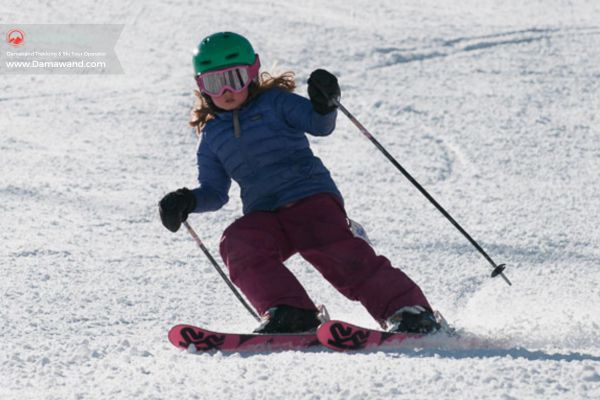
While the aforementioned skis are optimized for advancing intermediate to expert riders, beginners have distinct requirements. A narrower construction that can be easily managed on groomed and somewhat uneven hardpack surfaces is essential. Furthermore, a soft and lightweight build that responds willingly even with moderate input significantly enhances the prospects of making progress during those initial ski outings. To streamline the process, a package that includes dependable bindings attached to the skis is also advantageous.
Numerous prominent ski brands produce entry-level models, often presenting a more simplified version of their core all-mountain designs. In this context, Rossignol’s Experience 78 stands out as an ideal choice that meets all the essential criteria. Sharing a similar shape with the Experience 86, the Experience 78 trades the 86’s robust foundation for reduced width and increased flexibility. Overall, its design is exceptionally user-friendly and well-suited for consistent use on green and blue runs throughout the season. Additionally, the included Look bindings are of high quality and have a proven track record. What makes the Rossignol Experience 78 especially appealing is that you won’t outgrow them as quickly as you might with a pair of purely entry-level and overly flexible skis. Nonetheless, individuals who are quick learners or plan to spend a lot of time skiing may find higher-end models like the Atomic Bent to be a better fit.
Salomon QST 106 ($750)
- Ski Model: Salomon QST 106
- Ski Category: All-mountain back
- Recommended Skill Level: Advanced to expert
- Ski Dimensions: 139-106-126mm
- Available Widths: 92, 98mm
- Positive Aspects: Exceptional flotation and performance in soft snow conditions.
- Considerations: Groomed terrain performance is predictably less impressive.

Transitioning to a ski that thrives in powder, Salomon’s QST 106 represents a wide and exhilarating freeride design. Having garnered industry acclaim across multiple generations, Salomon’s latest model significantly emphasises enhancing off-piste maneuverability, floatation, and playfulness. Achieving this goal involved making relatively modest adjustments, including increasing the rocker in the ski’s profile, adopting a revised and more tapered shape, and implementing minor modifications to the ski’s construction. The result is a ski that brings smiles to those who relish their days exploring the outer fringes of the ski resort. The QST 106 surpasses lofty expectations in soft snow conditions (almost venturing into powder ski territory), demonstrating remarkable predictability and smooth handling in choppy terrain. The improved control also renders the latest QST impressively agile in tight spots. This ski manages to tick nearly all the boxes for the all-mountain wide category.
As anticipated, these design refinements do not translate into standout performance on groomed slopes. While the QST has shown gradual improvement over the years in turn initiation and edge grip, it struggles to match the capabilities of the aforementioned top picks at high speeds. The ski’s front end can feel somewhat lightweight and is less receptive to aggressive skiing on icy groomed trails. Consequently, the QST falls short of being an all-around performer when compared to models like the Mantra and Enforcer. Still, it remains a legitimate all-mountain option, particularly in regions that receive substantial amounts of powder, such as the West Coast, Colorado, or Utah. For those fortunate individuals who regularly encounter even deeper snowfall, Salomon offers the QST Blank, which boasts a broader 112-millimeter waist width.
For more information about the best skis in Iran, you can contact Damavand Guide Iran, an adventure tour operator, for the best advice.
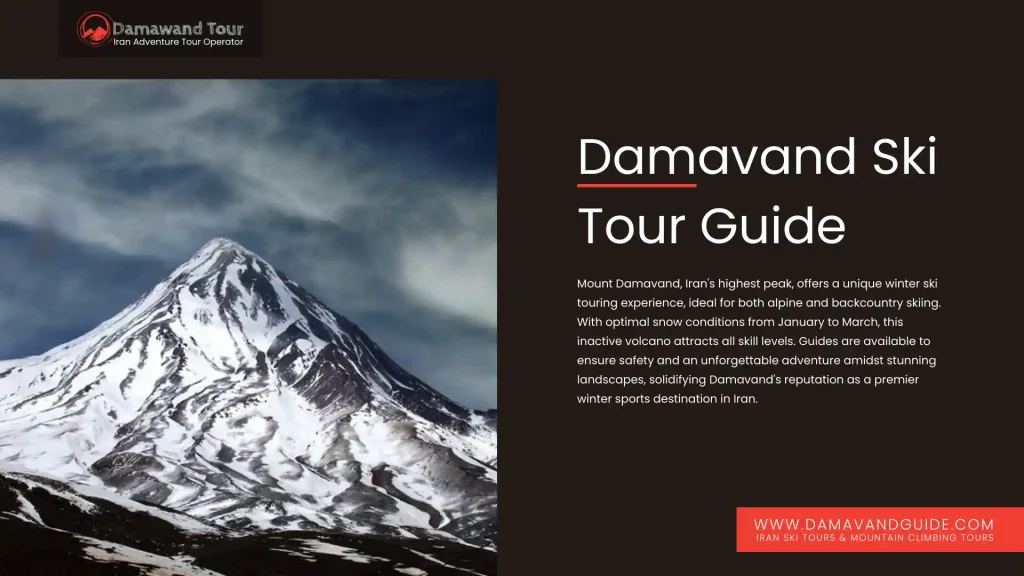
Damavand Ski Tour Guide
Damavand Ski Tour Guide offers essential information for skiing enthusiasts looking to explore the highest peak in Iran during winter. As part of Iran’s ski resorts, Mount Damavand provides a unique experience for those seeking adventure. This inactive volcano, covered in snow, is ideal for various types of skiing, including alpine skiing and backcountry skiing. With its high altitude and long slopes, the mountain attracts both beginners and experienced skiers. The best time for a Damavand ski tour is between January and March when snow conditions are optimal.
Guides are available to help travellers navigate the terrain, ensuring safety and an unforgettable skiing experience. In addition to skiing, visitors can enjoy stunning views of the surrounding landscapes. Whether you’re an expert or new to the sport, Damavand offers an exceptional combination of natural beauty and skiing challenges, making it one of Iran’s top destinations for winter sports.

